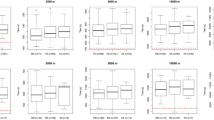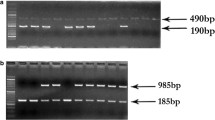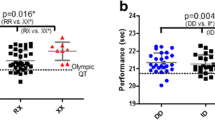Abstract
We have previously demonstrated that, ACE D allele may be related with a better performance in short duration aerobic endurance in a homogeneous cohort with similar training backgrounds. We aimed to study the variation in the short-duration aerobic performance development amongst ACE genotypes in response to identical training programs in homogeneous populations. The study group consisted of 186 male Caucasian non-elite Turkish army recruits. All subjects had undergone an identical training program with double training session per day and 6 days a week for 6 months. Performances for middle distance runs (2,400 m) were evaluated on an athletics track before and after the training period. ACE gene polymorphisms were studied by PCR analysis. The distribution of genotypes in the whole group was 16.7% II, n = 31; 46.2% ID, n = 86; 37.1% DD, n = 69. Subjects with ACE DD genotype had significantly higher enhancement than the ID (P < 0.01) and II (P < 0.05) genotype groups. Around 2,400 m performance enhancement ratios showed a linear trend as ACE DD > ACE ID > ACE II (P value for Pearson χ2 = 0.461 and P value for linear by linear association = 0.001). ACE DD genotype seems to have an advantage in development in short-duration aerobic performance. This data in unison with the data that we have obtained from homogenous cohorts previously is considered as an existence of threshold for initiation of ACE I allele effectiveness in endurance performance. This threshold may be anywhere between 10 and 30 min with lasting maximal exercises.
Similar content being viewed by others
References
Alvarez R, Terrados N, Ortalano R, Iglesias-Cubero G, Requero JR, Batalla A, Cortina A (2000) Genetic variation in the renin-angiotensin system and athletic performance. Eur J Appl Physiol 82(1–2):117–120
Cam FS, Colakoglu M, Sekuri C, Colakoglu S, Sahan C, Berdeli A (2005) Association between the ACE I/D polymorphism and physical performance in a homogeneous non-elite cohort. Can J Appl Physiol 30(1):74–86
Cam S, Colakoglu M, Colakoglu S, Sekuri C, Berdeli A (2006) ACE I/D gene polymorphism and aerobic endurance development in response to training in a non-elite female cohort. Scand J Med Sci Sports (in press)
Colakoglu M, Cam FS, Kayitken B, Cetinoz F, Colakoglu S, Turkmen M, Sayin M (2005) ACE genotype may have an effect on single vs multiple set preferences in strength training. Eur J Appl Physiol 95:20–27
De Sousa E, Veksler V, Bigard X, Mateo P, Ventura-Clapier R (2000) Heart failure affects mitochondrial but not myofibrillar intrinsic properties of skeletal muscle. Circulation 102:1847–1853
Folland J, Leach B, Little T, Hawker K, Myerson S, Montgomery H, Jones D (2000) Angiotensin-converting enzyme genotype affects the response of human skeletal muscle to functional overload. Exp Physiol 85:575–579
Davis GK, Millner RW, Roberts DH (2000) Angiotensin converting enzyme (ACE) gene expression in the human left ventricle: effect of ACE gene insertion/deletion polymorphism and left ventricular function. Eur J Heart Fail 2:253–256
Gayagay G, Yu B, Hambly B, Boston T, Hahn A, Celermajer DS, Trent RJ (1998) Elite endurance athletes and the ACE I allele—the role of genes in athletic performance. Hum Genet 103:48–50
Hopkinson NS, Nickol AH, Payne J, Hawe E, Man WD-C, Moxham J, Montgomery H, Polkey MI (2004) Angiotensin converting enzyme genotype and strength in chronic obstructive pulmonary disease. Am J Respir Crit Care Med 170:395–399
Martin DE (1990) Training and performance of women distance runners: a contemporary perspective. New Stud Athl 5 (2):45–68
Mizuiri S, Hemmi H, Kumanomidou H et al (1997). Decreased renal ACE mRNa levels in healthy subjects with II ACE genotype and diabetic nephropathy. J Am Soc Nephrol 8:115A
Montgomery HE, Clarkson P, Dollery CM, Prasad K, Losi MA, Hemingway H, Statters D, Jubb M, Girvain M, Varnava A, World M, Deanfield J, Talmud P, McEwan JR, McKenna WJ, Humphries S (1997) Association of angiotensin-converting enzyme gene I/D polymorphism with change in left ventricular mass in response to physical training. Circulation 96(3):741–747
Montgomery HE, Marshall R, Hemingway H, Myerson S, Clarkson P (1998) Human gene for physical performance. Nature 393:221–222
Myerson S, Hemingway H, Budget R, Martin J, Humphries S, Montgomery (1999) Human angiotensin I-converting enzyme gene and endurance performance. J Appl Physiol 87(4):1313–1316
Myerson SG, Montgomery HE, Whittingham M, Jubb M, World MJ, Humphries SE, Pennell DJ (2001) Left ventricular hypertrophy with exercise and ACE gene insertion/deletion polymorphism: a randomized controlled trial with losartan. Circulation 103(2):226–230
Nazarov IB, Woods DR, Montgomery HE, Shneirder OV, Kazakov VI, Tomilin NV, Rogozkin VA (2001) The angiotensin converting enzyme I/D polymorphism in Russian athletes. Eur J Hum Genet 9(10):797–801
Noakes TD (1988) The implications of exercise testing for prediction of athletic performance: a contemporary perspective. Med Sci Sports Exerc 21(4) 319–330
Noakes TD (1991) Lore of running, 3rd edn. Leisure Press/Human Kinetics, Campaign
Ohkuwa T, Yoshinobu K, Katsumata K, Nakao T, Miyamura M (1984) Blood lactate and glycerol after 400 m and 3000 m runs in sprint and long distance runners. Eur J Appl Physiol Occup Physiol 53:213–218
Rankinen T, Perusse L, Gagnon J, Chagnon YC, Leon AS, Skinner JS, Wilmore JH, Rao DC, Bouchard C (2000a) Angiotensin-converting enzyme ID polymorphism and fitness phenotype in the Heritage family study. J Appl Physiol 88:1029–1035
Rankinen T, Wolfarth B, Simoneau JA, Maier-Lenz D, Rauramaa R, Rivera MA, Boulay MR, Chagnon YC, Perusse L, Keul J, Bouchard C (2000b) No association between angiotensin-converting enzyme ID polymorphism and elite endurance athlete status. J Appl Physiol 88:1571–1575
Rattigan S, Dora KA, Tong AC, Clark MG (1996) Perfused skeletal muscle contraction and metabolism improved by angiotensin II-mediated vasoconstriction. Am J Physiol Endocrinol Metab 271:E96–E103
Rigat B, Hubert C, Alhenc-Gelas F, Cambien F, Corvol P, Soubrier F (1990) An insertion/deletion polymorphism in the angiotensin-1-converting enzyme gene accounting for half the variance of serum enzyme levels. J Clin Invest 86:1343–1346
Rigat B, Hubert C, Corvol P, Soubrier F (1992) PCR detection of the insertion / deletion polymorphism of the human angiotensin converting enzyme gene (DCP1) (dipeptidyl carboxypeptidase 1). Nucleic Acids Res 20:1433
Shanmugam V, Sell KW, Saha BK (1993) Mistyping ACE heterozygotes. PCR Methods Appl 3:120–121
Taylor RR, Mamotte CD, Fallon K, van Bockxmeer FM (1999) Elite athletes and gene for angiotensin-converting enzyme. J Appl Physiol 87:1035–1037
Woods D, Hickman K, Jamshidi Y, Brull D, Vassiliou V, Jones A, Humphries S, Montgomery H (2001) Elite swimmers and the D allele of the ACE I/D polymorphism. Hum Genet 108:230–232
Zhang B, Tanaka H, Shono N, Miura S, Kiyonaga A, Shindo M, Saku K (2003) The I allele of the angiotensin-converting enzyme gene is associated with an increased percentage of slow-twitch type I fibers in human skeletal muscle. Clin Genet 63(2):139–144
Zhao B, Moochhala SM, Tham S, Lu J, Chia M, Byrne C, Hu Q, Lee LKH (2003) Relationship between angiotensin-converting enzyme ID polymorphism and VO2max of Chinese males. Life Sci 73:2625–2630
Author information
Authors and Affiliations
Corresponding author
Rights and permissions
About this article
Cite this article
Cerit, M., Colakoglu, M., Erdogan, M. et al. Relationship between ace genotype and short duration aerobic performance development. Eur J Appl Physiol 98, 461–465 (2006). https://doi.org/10.1007/s00421-006-0286-6
Accepted:
Published:
Issue Date:
DOI: https://doi.org/10.1007/s00421-006-0286-6




